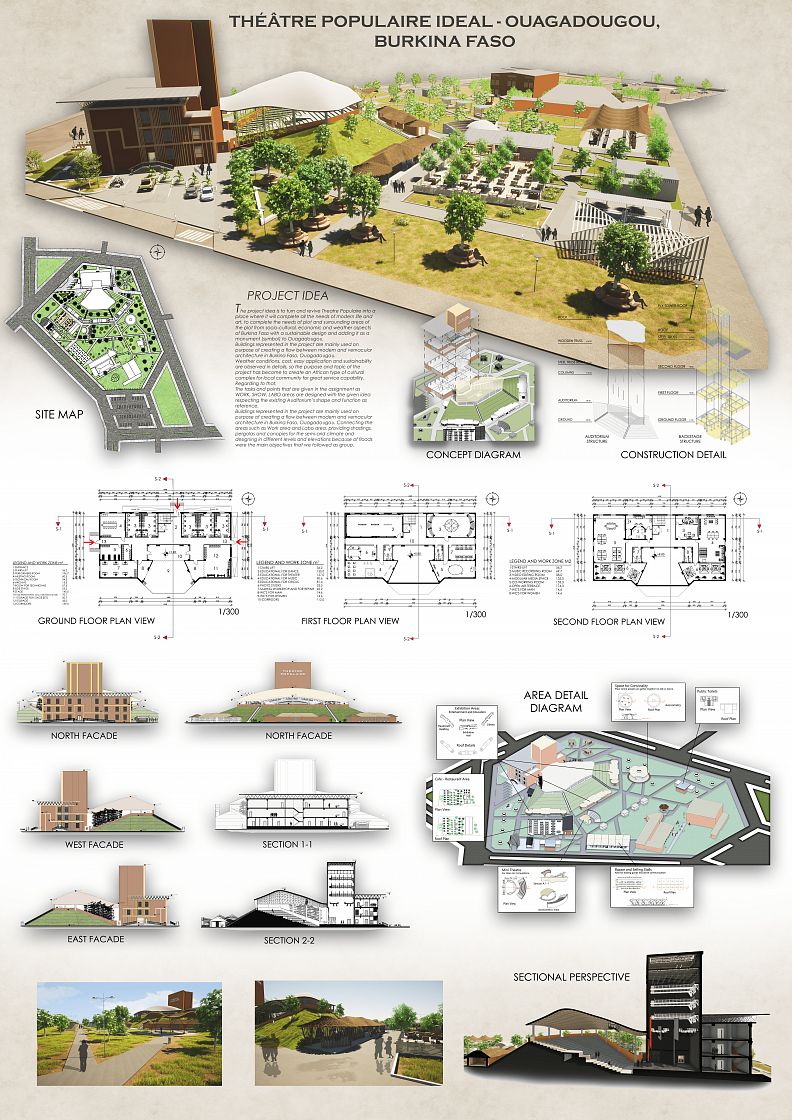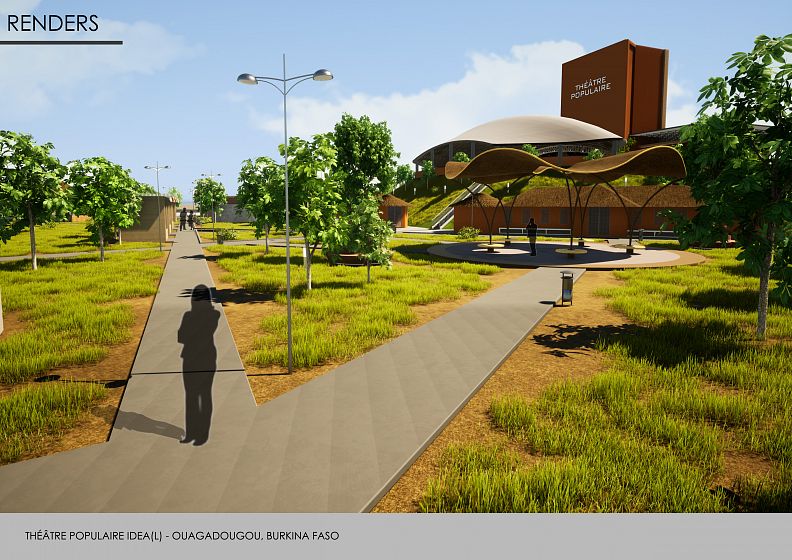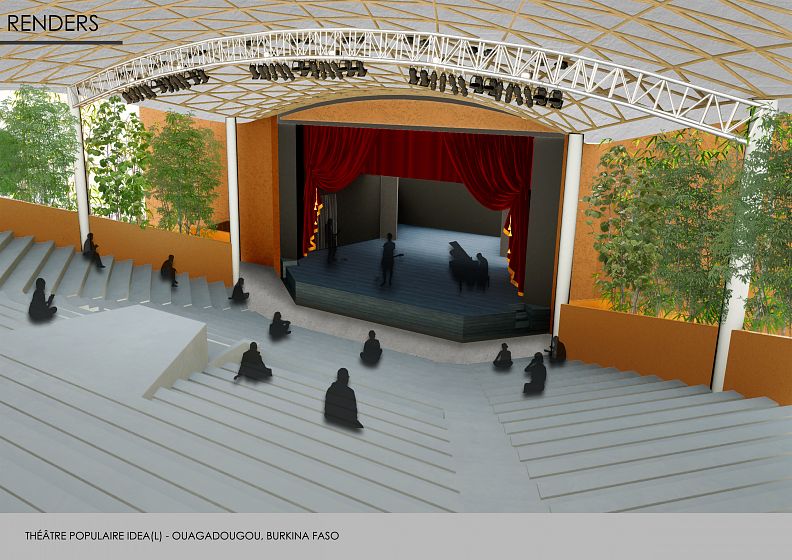THÉÂTRE POPULAIRE IDEAL - OUAGADOUGOU, BURKINA FASO

Project idea
The project idea is to turn and revive Theatre Populaire into a place where it will complete all the needs of modern life and art, to complete the needs of plot and surrounding areas of the plot from socio-cultural, economic and weather aspects of Burkina Faso with a sustainable design and adding it as a monument (symbol) to Ouagadougou.
Buildings represented in the project are mainly used on purpose of creating a flow between modern and vernacular architecture in Burkina Faso, Ouagadougou.
Weather conditions, cost, easy application and sustainability are observed in details, so the purpose and topic of the project has become to create an African type of cultural complex for local community for great service capability.
Regarding to that,
The tasks and points that are given in the assignment as WORK, SHOW, LABO areas are designed with the given idea respecting the existing Auditorium’s shape and function as reference.
Buildings represented in the project are mainly used on purpose of creating a flow between modern and vernacular architecture in Burkina Faso, Ouagadougou. Connecting the areas such as Work area and Labo area, providing shadings, pergolas and canopies for the semi-arid climate and designing in different levels and elevations because of floods were the main objectives that we followed as group.
Project description
During the analyses of surrounding and country environment we found out that people in Ouagadougou are traditional and cultural. So, the general idea was to use the vernacular architecture for designing the area because, the best ways to survive the conditions are to follow the native people that are there for centuries. The geometrical concept is followed by the theatres current shape with sharp edges. Respecting that the whole area is designed by developing the theatre. We as group tried to find ways for using the sunlight and especially shadows for achieving comfort and local reduction of temperature. Natural shading and local architecture is used mostly as concept, regarding the area we took advantage of horizontal expansion to avoid crowd. Idea is developed in order to revive the theatre and give it more harmonic and dynamic daily use to keep it alive. The general area is divided in two parts as backstage (work area/labo area) and open foyer (show area). The size of the proscenium is enlarged to needed dimensions. In the show area there is additional mini theatre for open air exhibitions and little shows for local use.
Continuity is the main topic, regarding the landscape design we lead people to go around the plot fluently visit places, enjoy, rest. This means that the public circulation is created to keep the area active in all the plot. With that approach after the play people won’t leave the area and they can enjoy different places in the same plot. This means that circulation of people will keep the place alive. The modern theatre is designed with all the needed technologies for the proscenium as lightning, sound systems. Fly Tower is designed to apply those technologies and at the same time it can be a symbol for Ouagadougou. The Fly Tower can be turned to a clock tower or it can remain as it is. To keep the existing auditorium effective and functional we covered it with vernacular design. This provided acoustics in interior space and protection from sun exposure and rain. Respecting the cost, instead of making different buildings we merged work and labo area and created a backstage building with both of them in one place.
Technical information
In the whole area the idea itself gives an impression for asymmetrical togetherness which leads to unusual architecture. We followed a modern approach for theatre building taking it to a European use standards but African look. However, the work area which we designed takes place as backstage and all the facilities built in it as a general administration and organization building. The work area leads us directly into the theatre and has warm communication with the stage that we made it bigger without demolishing. We provided 2 main and 2 reserve entrances and exits in the theatre regarding the face of the theatre and current accesses. In the design, the auditorium area is covered because of sun protection. After the proscenium the auditorium leads us to the show area. So, everything that is designed in the South area of the plot can be described as open foyer. Cafeterias, restaurants, exhibition areas and many more are implemented in the project to create the open foyer. We kept the training (LABO) and performing area behind the auditorium because of warm connection between labo and work area. Instead of construction and building we kept planning for adaptable urban design together with the areas needed to be connected with the theatre. In the general project we tried to be economic and eco-friendly, that is why there is no harm to existing trees and the theatre itself. Material choices are also made by following the local components as compacted soil, bricks, straw for the covers and timber. Regarding the culture we kept the “African Lapa” reference for our design and “Windcatcher” for ventilation. Structure is made different in every area starting from the work area has reinforced concrete, show area, proscenium and auditorium has steel truss construction with cover. Those two elements are the only construction methods used in the project.
Backstage is built in order to fulfill the needs of the actors and administrative staff. The proscenium is designed in a way so every viewer can see it from every corner. The existing auditorium shape is a reference for it. Side stages that are next to the proscenium are connected directly with storage-truck access. It gives us the easy placement of scene decoration and material transport.
There is 5 actor rooms for 4 people each which are approximately 40m2. Each room has toilet + shower and makeup places for actor needs. Those area also designed respecting the economy. 1st and 2nd floors of the backstage are designed for labo area. 1st floor has wide education spaces. Those spaces area in service for dance, theatre and different special activities. 2nd floor has services and working spaces for co-working, modular media room, recording studio and open air terrace for resting.
On the facade we have used wooden shutters instead of windows. That provides a natural ventilation inside of the building. The Fly Tower has 28.35m of height and it’s designed for scene lightning, catwalk and scenery. İt has a potential for being a landmark for the area.
Existing Auditorium has been covered by using wooden truss. This system is economic and also light. It is a tensile roof made with fabric so it protects the auditorium from sun exposure and rain. This allows the theatre to have daily activities even in the morning. Trees are put around it for natural look and it serves as isolation.
The buildings that are in shape of African Lapa on the south part of the theatre area cultural buildings which are multifunctional. They include exhibition halls, library and handicraft services for souvenirs. In cultural aspect people can get interesting knowledge for their culture.
Cafe & Restaurant is designed economic. Furniture as table and chairs for service are created from wooden pallets. Cheap, easy to install and it can be applied easily. Planting new trees inside of the cafeteria provides natural shading. Kitchen and the outbuilding is created with local materials such as local brick and wood. The bazaar place which is also designed as temporary stalls is created in a fluent place far from the theater to avoid garbage and smell around it. İt is still fluent for walking and gives a festival look to the place. As a last thing space for conviviality is provided in a covered place and it’s multifunctional. So people can either dance there or sit and talk.
In general the project is developed respecting the first idea and designed with the written points that are above.
Co-authors
Prof. D-r Aleksandar ANDOVSKI
Documentation
Show PDF 1Show PDF 2Show PDF 3Show PDF 4Show PDF 5Show PDF 6Show PDF 7Show PDF 8Show PDF 9Show PDF 10Show PDF 11Show PDF 12Show PDF 13Show PDF 14Show PDF 15Show PDF 16Show PDF 17Show PDF 18Show PDF 19Show PDF 20Show PDF 21Show PDF 22Show PDF 23Show PDF 24Show PDF 25Show PDF 26Show PDF 27Show PDF 28Show PDF 29


































